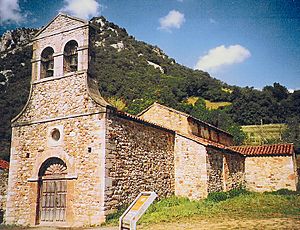Church of Santo Adriano de Tuñón facts for kids
Quick facts for kids Saint Adrian of TuñónSanto Adriano de Tuñón |
|
|---|---|
 |
|
| Religion | |
| Affiliation | Roman Catholic |
| Province | Asturias |
| Ecclesiastical or organizational status | Church |
| Year consecrated | 891 |
| Location | |
| Location | Santo Adriano, Spain |
| Architecture | |
| Architectural type | Church |
| Architectural style | Pre-Romanesque |
| Specifications | |
| Length | 14 metres (46 ft) |
| Width | 10 metres (33 ft) |
The Church of Santo Adriano de Tuñón is a very old and special church. It is located in the village of Tuñón, in Asturias, Spain. This church is a Roman Catholic church dedicated to Saint Adrian. It is famous for its unique Pre-Romanesque style. This means it was built before the Romanesque style became popular.
The church is found right by the River Trubia. It is also next to an old Roman road. King Alfonso III of Asturias and his wife, Queen Jimena of Navarra, started building it on January 24, 891. It was first built as a church for a monastery. The church changed a lot in the early 1100s. In June 1931, it was named a Spanish national monument. This means it is a very important historical building in Spain.
What the Church Looks Like
The church was originally built with a classic basilica shape. A basilica is a type of building with a large open space in the middle. Later, in the 1600s and 1700s, more parts were added. A new section was built at the western end. A bell gable was also added. A bell gable is a wall at the top of a building that holds bells.
Amazing Art Inside
Beautiful paintings on the walls were found again in the 1900s. These paintings are called frescoes. They are very special because they are the only remaining works by Mozarabic painters in Asturias. Mozarabic art is a style of art from Spain. It was created by Christians living under Muslim rule. These paintings show a unique blend of cultures and art styles from that time.
See also
 In Spanish: Santo Adriano de Tuñón para niños
In Spanish: Santo Adriano de Tuñón para niños
- Asturian art
- Catholic Church in Spain

